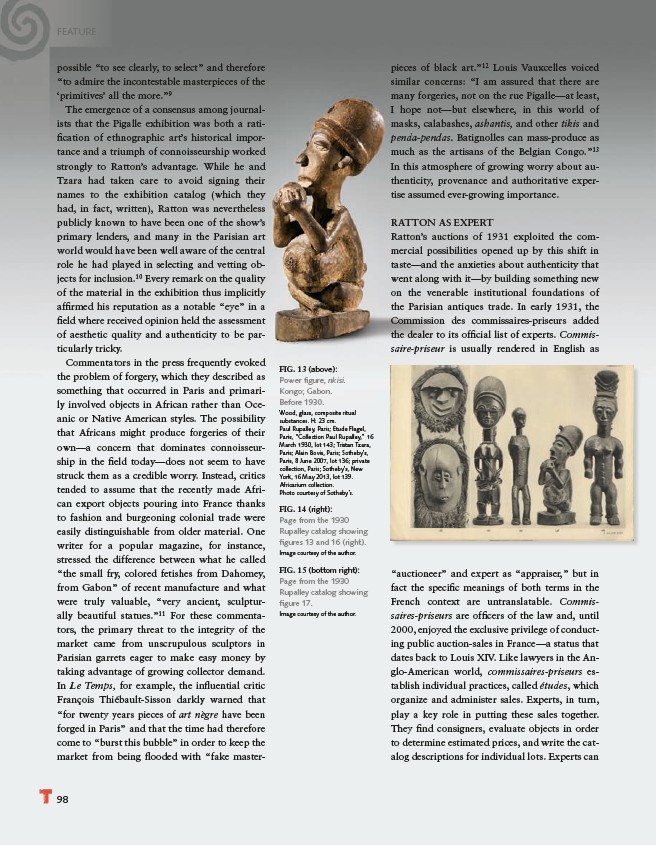
98
“auctioneer” and expert as “appraiser,” but in
fact the specifi c meanings of both terms in the
French context are untranslatable. Commissaires
priseurs are offi cers of the law and, until
2000, enjoyed the exclusive privilege of conducting
public auction-sales in France—a status that
dates back to Louis XIV. Like lawyers in the Anglo
American world, commissaires-priseurs establish
individual practices, called études, which
organize and administer sales. Experts, in turn,
play a key role in putting these sales together.
They fi nd consigners, evaluate objects in order
to determine estimated prices, and write the catalog
descriptions for individual lots. Experts can
possible “to see clearly, to select” and therefore
“to admire the incontestable masterpieces of the
‘primitives’ all the more.”9
The emergence of a consensus among journalists
that the Pigalle exhibition was both a ratifi
cation of ethnographic art’s historical importance
and a triumph of connoisseurship worked
strongly to Ratton’s advantage. While he and
Tzara had taken care to avoid signing their
names to the exhibition catalog (which they
had, in fact, written), Ratton was nevertheless
publicly known to have been one of the show’s
primary lenders, and many in the Parisian art
world would have been well aware of the central
role he had played in selecting and vetting objects
for inclusion.10 Every remark on the quality
of the material in the exhibition thus implicitly
affi rmed his reputation as a notable “eye” in a
fi eld where received opinion held the assessment
of aesthetic quality and authenticity to be particularly
tricky.
Commentators in the press frequently evoked
the problem of forgery, which they described as
something that occurred in Paris and primarily
involved objects in African rather than Oceanic
or Native American styles. The possibility
that Africans might produce forgeries of their
own—a concern that dominates connoisseurship
in the fi eld today—does not seem to have
struck them as a credible worry. Instead, critics
tended to assume that the recently made African
export objects pouring into France thanks
to fashion and burgeoning colonial trade were
easily distinguishable from older material. One
writer for a popular magazine, for instance,
stressed the difference between what he called
“the small fry, colored fetishes from Dahomey,
from Gabon” of recent manufacture and what
were truly valuable, “very ancient, sculpturally
beautiful statues.”11 For these commentators,
the primary threat to the integrity of the
market came from unscrupulous sculptors in
Parisian garrets eager to make easy money by
taking advantage of growing collector demand.
In Le Temps, for example, the infl uential critic
François Thiébault-Sisson darkly warned that
“for twenty years pieces of art nègre have been
forged in Paris” and that the time had therefore
come to “burst this bubble” in order to keep the
market from being fl ooded with “fake masterpieces
of black art.”12 Louis Vauxcelles voiced
similar concerns: “I am assured that there are
many forgeries, not on the rue Pigalle—at least,
I hope not—but elsewhere, in this world of
masks, calabashes, ashantis, and other tikis and
penda-pendas. Batignolles can mass-produce as
much as the artisans of the Belgian Congo.”13
In this atmosphere of growing worry about authenticity,
provenance and authoritative expertise
assumed ever-growing importance.
RATTON AS EXPERT
Ratton’s auctions of 1931 exploited the commercial
possibilities opened up by this shift in
taste—and the anxieties about authenticity that
went along with it—by building something new
on the venerable institutional foundations of
the Parisian antiques trade. In early 1931, the
Commission des commissaires-priseurs added
the dealer to its offi cial list of experts. Commissaire
priseur is usually rendered in English as
FEATURE
FIG. 13 (above):
Power fi gure, nkisi.
Kongo; Gabon.
Before 1930.
Wood, glass, composite ritual
substances. H: 23 cm.
Paul Rupalley, Paris; Étude Flagel,
Paris, “Collection Paul Rupalley,” 16
March 1930, lot 143; Tristan Tzara,
Paris; Alain Bovis, Paris; Sotheby’s,
Paris, 8 June 2007, lot 136; private
collection, Paris; Sotheby’s, New
York, 16 May 2013, lot 139.
Africarium collection.
Photo courtesy of Sotheby’s.
FIG. 14 (right):
Page from the 1930
Rupalley catalog showing
fi gures 13 and 16 (right).
Image courtesy of the author.
FIG. 15 (bottom right):
Page from the 1930
Rupalley catalog showing
fi gure 17.
Image courtesy of the author.